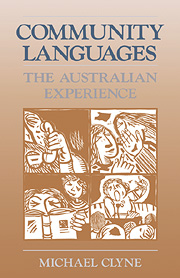Book contents
- Frontmatter
- Contents
- List of tables
- List of graphs
- Map of Australia
- Preface
- 1 Australia between monolingualism and multilingualism
- 2 Distribution and maintenance of community languages in Australia
- 3 The use of community languages in Australia
- 4 Structural and typological aspects of community languages
- 5 The formulation and implementation of language policies
- Appendix
- Glossary
- Bibliography
- Index
2 - Distribution and maintenance of community languages in Australia
Published online by Cambridge University Press: 09 November 2009
- Frontmatter
- Contents
- List of tables
- List of graphs
- Map of Australia
- Preface
- 1 Australia between monolingualism and multilingualism
- 2 Distribution and maintenance of community languages in Australia
- 3 The use of community languages in Australia
- 4 Structural and typological aspects of community languages
- 5 The formulation and implementation of language policies
- Appendix
- Glossary
- Bibliography
- Index
Summary
INTRODUCTORY REMARKS
One of the effects of the tension between monolingualism and multilingualism in Australia has been that some people develop and maintain bilingualism, while others shift mainly or totally to English. This is the focus of Chapter 2.
In this chapter I will first examine the distribution of languages other than English in, and throughout Australia. Three sets of data, each distinctive and useful but in their own ways limited, form the basis of our information on community language behaviour in Australia. They are:
the 1976 Census, which inquired about languages used regularly by persons aged 5 and over;
the Australian Bureau of Statistics (ABS) 1983 Survey, administered on only two-thirds of 1 per cent of the population aged 15 and over, which elicited language(s) first used and currently used in specific domains and channels (home, work, socially; in speaking, reading and writing);
the 1986 Census which gathered data on home language of the entire population.
Having drawn attention to weaknesses in the questions and in the processing of the responses, I shall make a comparison between the 1976 and 1986 data, and discuss regional variation. The statistics and the results of small-scale surveys will be used to discuss the relative language maintenance and shift in different ethnolinguistic groups and the variables mediating language maintenance and shift.
- Type
- Chapter
- Information
- Community LanguagesThe Australian Experience, pp. 36 - 111Publisher: Cambridge University PressPrint publication year: 1991



